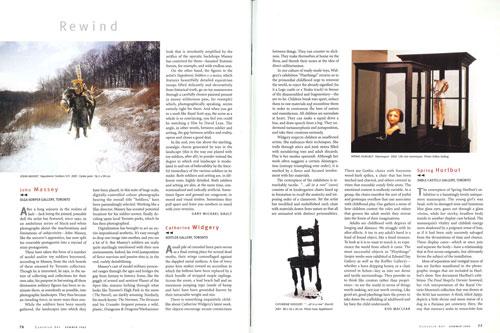Sable-Castelli Gallery, Toronto
The centrepiece of Spring Hurlbut’s exhibition is a hauntingly lovely antique-store mannequin. The young girl’s wax head, with its damaged nose and luminous blue glass eyes, gazes out through a glass vitrine, while her stocky, headless body stands in another display case behind. The mannequin’s vitality and childish energy seem shadowed by a poignant sense of loss, as if it had been only narrowly salvaged from the devastations of time and chance. These display cases—which at once join and separate the body—have a relationship that at first seems enigmatic, but ultimately forms the subject of the installation.
Ideas of separation and vestigial traces of loss are further manifested in the photographic images that are included in Hurlbut’s show. Two document Hurlbut’s exhibition The Final Sleep/Le Dernier Sommeil, her rich interpretation of the Royal Ontario Museum’s collection that was shown at the ROM last summer. A third, titled Jappy, depicts a little shrine and stone statue of a dog in a Parisian pet cemetery. Here, the way that memory seeks to resuscitate loss by fashioning material reminders—monuments, photographs, rituals—is evident, as it is in three daguerreotypes of the mannequin. Together, the works outline a dialectic between memory and loss, where evoked disappearances are layered with subtle speculations about death and sensibility.
The photographs of The Final Sleep, in capturing multiple reflections on glass vitrines, replicate the parallel layers of Hurlbut’s hypnotically beautiful arrangement of museum artifacts. It is as if the stuffed animals in the cases had acquired auras that allowed them to transcend their own mortal spans. In one photograph, the headless skeleton of a grey gibbon is counterpoised with the skull of a long-tusked marmoset, which lies on a swath of black velvet in front of the skeleton (a configuration that mirrors the decapitated mannequin). The reflections within the photograph superimpose the small, fiercely toothed skull onto the skeleton, evoking a meditation on the strange fact that bones and teeth survive both the more evanescent flesh and the cognition housed in the skull.
The daguerreotypes proffer a different metaphysical solace. Where photographs capture traces of presence with modern technology, Hurlbut and Mike Robinson, the daguerreian artist with whom she collaborated, employ a technique invented in the 1830s and a form (the miniature) that reproduces 19th-century rituals of commemoration and mourning. The three images in their shrine-like thermoplastic cases record the enclosed mannequin, itself a fabricated image of a living girl. Two feature frontal portraits, as if the hyperreal medium of the daguerreotype could instil an analogous life in the mannequin. The third daguerreotype shows the mannequin gazing into a mirror, imbuing this scene of reflection with a sense of active human subjectivity.
In the vitrines, the laces that trail from the wax head and the yoke of the mannequin are echoed in the undone strings of the underwear that clothes the girl’s body. They also underscore the other essential corporeal and cognitive disjoinings of the installation. Hurlbut’s attention to reflection and repetition insists on an afterlife of objects and images, perhaps even of consciousness itself. Far from morbid, her exhibition is saturated with a sense of consolation, where death is not a finality, but a state that engenders altered perception.
From the Summer 2002 issue of Canadian Art

 Spread of "Rewind: Spring Hurlbut" from Summer 2002 issue.
Spread of "Rewind: Spring Hurlbut" from Summer 2002 issue.







